Women's Social & Political Union (Suffragettes)
On 27th February 1900, representatives of all the socialist groups in Britain (the Independent Labour Party (ILP), the Social Democratic Federation (SDF) and the Fabian Society, met with trade union leaders at the Congregational Memorial Hall in Farringdon Street. After a debate the 129 delegates decided to pass the motion proposed by Keir Hardie to establish "a distinct Labour group in Parliament, who shall have their own whips, and agree upon their policy, which must embrace a readiness to cooperate with any party which for the time being may be engaged in promoting legislation in the direct interests of labour." To make this possible the Conference established a Labour Representation Committee (LRC). (1)
Emmeline Pankhurst hoped the new Labour Party would support votes for women on the same terms as men. Although the party made it clear in its programme it favoured equal rights for men and women. Hardie argued for "the vote for women on the same terms as it is or may be granted to men". However, others in the party, including Isabella Ford, thought that as large number of working-class males did not have the vote, they should be demanding "full adult suffrage". Philip Snowden pointed out that if only middle-class women got the vote it would favour the Conservative Party. This was also the view of left-wing members of the Liberal Party such as David Lloyd George. (2)
In the 1902 Labour Party conference Emmeline Pankhurst created controversy when she proposed that "in order to improve the economic and social condition of women, it is necessary to take immediate steps to secure the granting of the suffrage to women on the same terms as it is, or may be, granted to men". This was not accepted and instead a resolution calling for "adult suffrage" became party policy.
Pankhurst's views on limited suffrage received a great deal of criticism. One of its leaders, John Bruce Glasier, had been a long-term supporter of universal suffrage, and like his wife, Katharine Glasier, was particularly opposed to Pankhurst's views. He recorded in his diary that he disapproved of her "individualist sexism". At a meeting with Emmeline and her daughter, Christabel Pankhurst, he claimed that the two women "were not seeking democratic freedom, but self-importance". (3) Trade union leader, Henry Snell, agreed: "Mrs. Pankhurst was magnetic, courageous, audacious, and resolute. Mrs. Pankhurst was an autocrat masquerading as a democrat". (4)
Women's Social and Political Union
After her defeat at conference, Emmeline Pankhurst decided to leave the Labour Party and in October 1903 decided to establish the Women's Social and Political Union (WSPU). Emmeline stated that the main aim of the organisation was to recruit working class women into the struggle for the vote. "We resolved to limit our membership exclusively to women, to keep ourselves absolutely free from any party affiliation, and to be satisfied with nothing but action on our question. Deeds, not words, was to be our permanent motto." (5)
Some early members included Christabel Pankhurst, Sylvia Pankhurst, Adela Pankhurst, Emmeline Pethick-Lawrence, Marion Wallace-Dunlop, Elizabeth Robins, Flora Drummond, Annie Kenney, Mary Gawthorpe, May Billinghurst, Elizabeth Wolstenholme-Elmy, Mary Allen, Winifred Batho, Mary Leigh, Mary Richardson, Ethel Smyth, Teresa Billington-Greig, Helen Crawfurd, Eileen Casey, Emily Davison, Charlotte Despard, Mary Clarke, Margaret Haig Thomas, Cicely Hamilton, Florence Tunks, Hilda Burkitt, Clara Giveen, Eveline Haverfield, Edith How-Martyn, Constance Lytton, Kitty Marion, Helen Craggs, Ada Wright, Dora Marsden, Hannah Mitchell, Margaret Nevinson, Evelyn Sharp, Nellie Martel, Helen Fraser, Jennie Baines, Emma Sproson, Minnie Baldock and Octavia Wilberforce.
The main objective was to gain, not universal suffrage, the vote for all women and men over a certain age, but votes for women, “on the same basis as men.” This meant winning the vote not for all women but for only the small stratum of women who could meet the property qualification. As one critic suggested, it was "not votes for women", but “votes for ladies.” As an early member of the WSPU, Dora Montefiore, pointed out: "The work of the Women’s Social and Political Union was begun by Mrs. Pankhurst in Manchester, and by a group of women in London who had revolted against the inertia and conventionalism which seemed to have fastened upon... the NUWSS." (6)
Sylvia Pankhurst studied at Manchester Art School. Although a committed artist, she began spending more and more time working for women's suffrage. When the Women Social & Political Union was formed, Sylvia employed her artistic skills for the organisation. This included designing the Membership Card for the WSPU. It portrayed "in clear, bright colours, the working women, in aprons, clogs, and shawls, whose lives she hoped the campaign would improve." (6a)
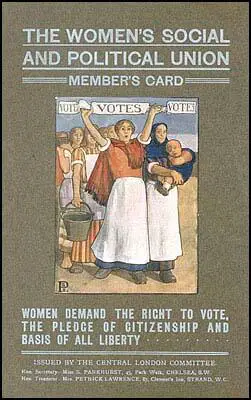
The forming of the WSPU upset both the National Union of Women's Suffrage Societies (NUWSS) and the Labour Party, the only party at the time that supported universal suffrage. They pointed out that in 1903 only a third of men had the vote in parliamentary elections. On the 16th December 1904, The Clarion published a letter from Ada Nield Chew, a leading figure in the Independent Labour Party, attacking WSPU policy: "The entire class of wealthy women would be enfranchised, that the great body of working women, married or single, would be voteless still, and that to give wealthy women a vote would mean that they, voting naturally in their own interests, would help to swamp the vote of the enlightened working man, who is trying to get Labour men into Parliament." (7)
The following month Christabel Pankhurst replied to the points that Ada Nield Chew made: "Some of us are not at all so confident as is Mrs Chew of the average middle class man's anxiety to confer votes upon his female relatives." A week later Ada Nield Chew retorted that she still rejected the policies in favour of "the abolition of all existing anomalies... which would enable a man or woman to vote simply because they are man or woman, not because they are more fortunate financially than their fellow men and women". (8)
As the authors of One Hand Tied Behind Us (1978) pointed out: "The fiery exchange ran on through the spring and into March. The two women both relished confrontation, and neither was prepared to concede an inch. They had no sympathy for the other's views, and shared no common experiences that might help to bridge the chasm... Christabel, daughter of a barrister... had little personal experience of working women's lives. Ada Nield Chew had known little else... her life had been a series of battles against women's low wages and appalling working conditions." (9)
The WSPU was often accused of being an organisation that existed to serve the middle and upper classes. As Annie Kenney was one of the organizations few working class members, when the WSPU decided to open a branch in the East End of London, she was asked to leave the mill and become a full-time worker for the organisation. Annie joined Sylvia Pankhurst in London and they gradually began to persuade working-class women to join the WSPU. (10)
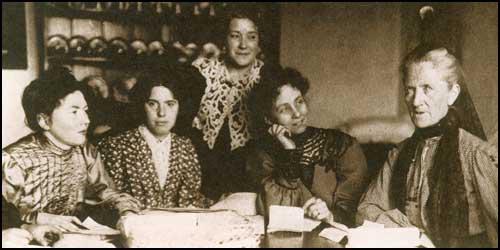
Nellie Martel, Emmeline Pankhurst and Charlotte Despard.
Teresa Billington Greig found Emmeline Pankhurst a difficult colleague: "To work alongside of her day by day was to run the risk of losing yourself. She was ruthless in using the followers she gathered around her, as she was ruthless to herself. She took advantage of both their strengths and their weaknesses suffered with you and for you while she believed she was shaping you and used every device of suppression when the revolt against the shaping came. She was a most astute statesman, a skilled politician, a self-dedicated reshaper of the world - and a dictator without mercy". (11)
Emmeline Pankhurst was an impressive orator: "The crowd came - packing the hall to overflowing. The rowdy youths came. And one other factor I had scarcely fully reckoned upon came - Mrs. Pankhurst. She held that audience in the hollow of her hand. When a youth interrupted she turned and dealt with him, silenced him, and, without faltering in the thread of her speech, used him as an illustration of an argument. The audience was so intent to hear every word that even when one little group of youths let out that aforementioned evil-smelling gas it did no more than cause a faint stir in one small corner of the hall. As Mrs. Pankhurst continued the interruptions got fewer and fewer, and at last ceased altogether. Even when at the end came question-time, members of the audience were uncommonly chary of delivering themselves into her hands. That meeting was a revelation of the power of a great speaker." (12)
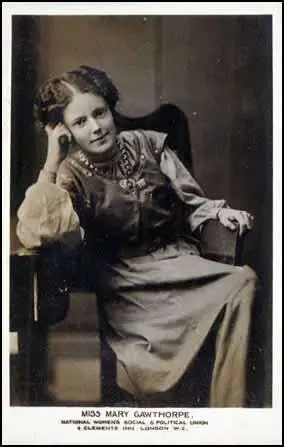
By 1905 the media had lost interest in the struggle for women's rights. Newspapers rarely reported meetings and usually refused to publish articles and letters written by supporters of women's suffrage. In 1905 the WSPU decided to use different methods to obtain the publicity they thought would be needed in order to obtain the vote. It seemed certain that the Liberal Party would form the next government. Therefore, the WSPU decided to target leading figures in the party. (13)
On 13th October 1905, Christabel Pankhurst and Annie Kenney attended a meeting in London to hear Sir Edward Grey, a minister in the British government. When Grey was talking, the two women constantly shouted out, "Will the Liberal Government give votes to women?" When the women refused to stop shouting the police were called to evict them from the meeting. Pankhurst and Kenney refused to leave and during the struggle a policeman claimed the two women kicked and spat at him. Pankhurst and Kenney were both arrested. (14)
Christabel Pankhurst was charged with assaulting the police and Annie Kenney with obstruction. They were both found guilty. Pankhurst was fined ten shillings or a jail sentence of one week. Kenney was fined five shillings, with an alternative of three days in prison. When the women refused to pay the fine they were sent to prison. The case shocked the nation. For the first time in Britain women had used violence in an attempt to win the vote. (15)
Emmeline Pankhurst was very pleased with the publicity achieved by the two women. "The comments of the press were almost unanimously bitter. Ignoring the perfectly well-established fact that men in every political meeting ask questions and demand answers of the speakers, the newspapers treated the action of the two girls as something quite unprecedented and outrageous... Newspapers which had heretofore ignored the whole subject now hinted that while they had formerly been in favour of women's suffrage, they could no longer countenance it." (16)
Claire Louise Eustace has argued: "The subsequent press attention given to this militant protest publicized the demands of women suffragists to a degree that made existing organisations interested in suffrage re-examine their own campaigns. It also led to a dramatic increase in interest in the WSPU, and the formation of new branches in other areas of Britain, especially after it was decided to relocate the WSPU headquarters to London in 1906." (16a)
1906 Liberal Government
In the 1906 General Election the Liberal Party won 399 seats and gave them a large majority over the Conservative Party (156) and the Labour Party (29). Pankhurst hoped that Henry Campbell-Bannerman, the new prime minister, and his Liberal government, would give women the vote. However, several Liberal MPs were strongly against this. It was pointed out that there were a million more adult women than men in Britain. It was suggested that women would vote not as citizens but as women and would "swamp men with their votes". (17)
Campbell-Bannerman gave his personal support to Emmeline Pankhurst and Millicent Fawcett, the leader of the National Union of Women's Suffrage Societies (NUWSS), though he warned them that he could not persuade his colleagues to support the legislation that would make their aspiration a reality. Despite the unwillingness of the Liberal government to introduce legislation, Fawcett remained committed to the use of constitutional methods to gain votes for women. However, Pankhurst took a very different view. (18)

On 23rd October, 1906, Emmeline Pankhurst organised a huge rally in Caxton Hall, and a deputation went to the House of Commons to demand the vote: She later wrote about this in her autobiography, My Own Story (1914): "Those women had followed me to the House of Commons. They had defied the police. They were awake at last thev were prepared to do something that women had never done before - fight for themselves. Women had always fought for men, and for their children. Now they were ready to light for their own human rights. Our militant movement was established.'' (19)
To coincide with the opening of parliament on 13th February 1907 the WSPU organized the first Women's Parliament at Caxton Hall. The women were confronted by mounted police. Fifty-eight women appeared in court as a result of the conflict. Most of those arrested received seven to fourteen days in Holloway Prison, though Sylvia Pankhurst and Charlotte Despard got three weeks. (20)
If you find this article useful, please feel free to share on websites like Reddit. You can follow John Simkin on Twitter, Google+ & Facebook or subscribe to our monthly newsletter.
Some leading members of the Women's Social and Political Union began to question the leadership of Emmeline Pankhurst and Christabel Pankhurst. These women objected to the way that the Pankhursts were making decisions without consulting members. They also felt that a small group of wealthy women like Emmeline Pethick-Lawrence were having too much influence over the organisation. In the autumn of 1907, Teresa Billington-Greig, Elizabeth How-Martyn, Dora Marsden, Helena Normanton, Margaret Nevinson and Charlotte Despard and seventy other members of the WSPU left to form the Women's Freedom League (WFL). (21)
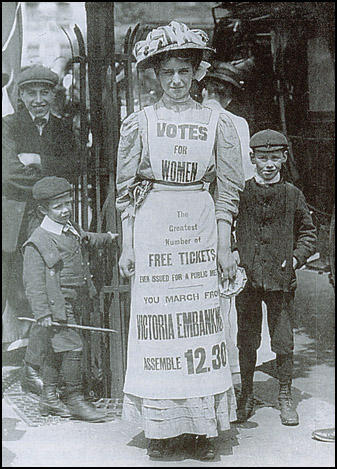
In January 1908 Edith New and Ada Nield Chew chained themselves to the railings of 10 Downing Street. According to The Daily Express: "Each suffragist wore round her waist a long, steel chain - not unlike a very heavy dog chain. Each took the loosened end of the chain, threw it round the railings, and fixed it to the rest of the chain. This was done so deftly that it was not until the police heard the click of the lock that they understood the clever move by which the suffragists had outwitted them, and prevented for a time their own removal. Votes for women! shouted the two voluntary prisoners simultaneously. Votes for Women!" (21a)
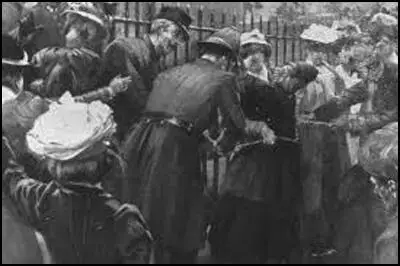
In February, 1908, Emmeline Pankhurst was arrested and was sentenced to six weeks in prison. Fran Abrams the author of Freedom's Cause (2003), explained how she reacted to the situation: "Emmeline knew what to expect - she had by then heard graphic descriptions of prison life from Sylvia and Adela as well as from Christabel. She was shocked, though, when the wardress asked her to undress in order to put on her prison uniform - stained underwear, rough brown and red striped stockings and a dress with arrows on it. She was given coarse but clean sheets, a towel, a mug of cold cocoa and a thick slice of brown bread, and taken to her cell. Second division prisoners were kept in solitary confinement and were let out of their cells only for an hour's exercise each day. They were not allowed to receive letters for four weeks. Even though she had prepared herself for the experience, the reality hit her harder than she had anticipated." (22)
The WSPU organised a mass meeting to take place on 21 June 1908 called Women's Sunday at Hyde Park. The leadership intended it "would out-rival any of the great franchise demonstrations held by the men" in the 19th century. Sunday was chosen so that as many working women as possible could attend. It is claimed that it attracted a crowd of over 300,000. At the time, it was the largest protest to ever have taken place in Britain. Speakers included Emmeline Pankhurst, Christabel Pankhurst, Adela Pankhurst, Emmeline Pethick-Lawrence, Mary Gawthorpe, Jennie Baines, Rachel Barrett, Marie Brackenbury, Georgina Brackenbury, Annie Kenney, Nellie Martel, Marie Naylor, Flora Drummond, Edith New and Gladice Keevil. (22x)
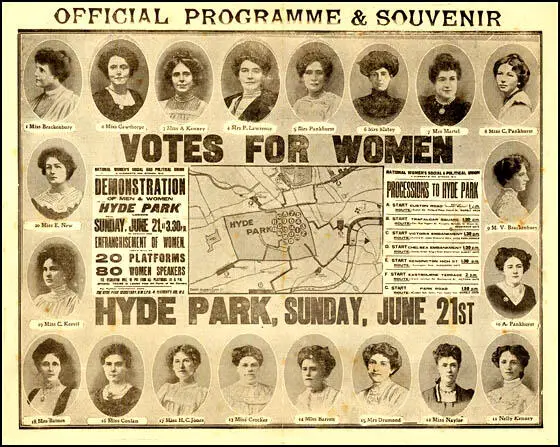
On 30th June, 1908, Edith New attended a public meeting in Parliament Square. The authorities decided to send in 5,000 foot police and 50 mounted men to break-up the meeting. Sylvia Pankhurst later reported: "Women spoke from the steps of the Government buildings and offices in Broad Sanctuary, they lifted themselves above the people by the railings round the Abbey Gardens and Palace Yard, or raised their voices standing among the crowds on road or pavement. They were torn by the harrying constables from their foothold and flung into the masses of people... Then roughs appeared, organized gangs, who treated the women with every type of indignity... I was obliged to drop my handbag with keys and purse, to have my hands free to protect myself. The roughs were constantly attempting to drag women down side streets away from the main body of the crowd... Enraged by the violence and indecency in the Square, Mary Leigh and Edith New took a cab into Downing Street, and flung two small stones through the windows of the Prime Minister's house." (22a) It was later revealed that these gangs had been hired by Scotland Yard. (22b)
The next day at Westminster police court twenty-seven women were sent to prison for terms varying from one to two months. Edith New and Mary Leigh, were sentenced to two months in Holloway Prison. In court the women wore white dresses and were relieved to hear the sentence because they feared it would be a much longer sentence. However, the Manchester Guardian protested in a leading article: "Their stringent imprisonment... violates the public conscience." (22c) However, Millicent Fawcett, leader of the National Union of Women's Suffrage Societies (NUWSS), said later that it was this incident that resulted in her condemning the methods being used by the WSPU. (22d)
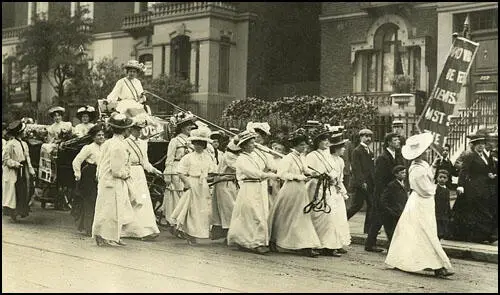
from Holloway to Queen's Hall on 23rd August 1908.
Edith New and Mary Leigh were released from prison on 23rd August. They were welcomed on release by a team of women in white dresses who drew their carriage from Holloway to Clements Inn. They were greeted by a brass band and accorded a ceremonial welcome breakfast attended by the two main leaders of the WSPU, Emmeline Pankhurst and Christabel Pankhurst. 22e)
Hunger Strikes
On 25th June 1909, Marion Wallace-Dunlop was found guilty of wilful damage and when she refused to pay a fine she was sent to prison for a month. On 5th July, 1909 she petitioned the governor of Holloway Prison: “I claim the right recognized by all civilized nations that a person imprisoned for a political offence should have first-division treatment; and as a matter of principle, not only for my own sake but for the sake of others who may come after me, I am now refusing all food until this matter is settled to my satisfaction.” (23)
Wallace-Dunlop refused to eat for several days. Afraid that she might die and become a martyr, it was decided to release her. According to Joseph Lennon: "She came to her prison cell as a militant suffragette, but also as a talented artist intent on challenging contemporary images of women. After she had fasted for ninety-one hours in London’s Holloway Prison, the Home Office ordered her unconditional release on July 8, 1909, as her health, already weak, began to fail". (24)
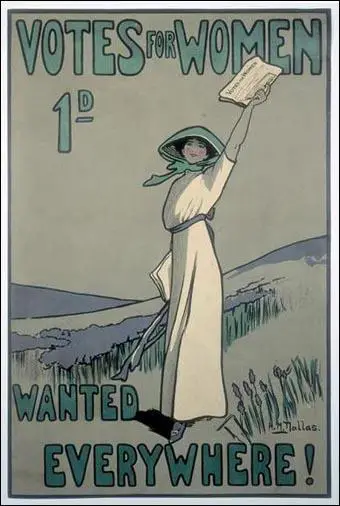
On 22nd September 1909 Charlotte Marsh, Laura Ainsworth and Mary Leigh were arrested while disrupting a public meeting being held by Herbert Asquith. Marsh, Ainsworth and Leigh were all sentenced to two weeks' imprisonment. They immediately decided to go on hunger-strike, a strategy developed by Marion Wallace-Dunlop a few weeks earlier. Wallace-Dunlop had been immediately released when she had tried this in Holloway Prison, but the governor of Winson Green Prison, was willing to feed the three women by force. (25)
Mary Leigh, described what it was like to be force-fed: "On Saturday afternoon the wardress forced me onto the bed and two doctors came in. While I was held down a nasal tube was inserted. It is two yards long, with a funnel at the end; there is a glass junction in the middle to see if the liquid is passing. The end is put up the right and left nostril on alternative days. The sensation is most painful - the drums of the ears seem to be bursting and there is a horrible pain in the throat and the breast. The tube is pushed down 20 inches. I am on the bed pinned down by wardresses, one doctor holds the funnel end, and the other doctor forces the other end up the nostrils. The one holding the funnel end pours the liquid down - about a pint of milk... egg and milk is sometimes used." Leigh's graphic account of the horrors of forcible feeding was published while she was still in prison. Afraid that she might die and become a martyr, it was decided to release her. (26)
Hunger-strikes now became the accepted strategy of the WSPU. In one eighteen month period, Emmeline Pankhurst endured ten hunger-strikes. She later recalled: "Hunger-striking reduces a prisoner's weight very quickly, but thirst-striking reduces weight so alarmingly fast that prison doctors were at first thrown into absolute panic of fright. Later they became somewhat hardened, but even now they regard the thirst-strike with terror. I am not sure that I can convey to the reader the effect of days spent without a single drop of water taken into the system. The body cannot endure loss of moisture. It cries out in protest with every nerve. The muscles waste, the skin becomes shrunken and flabby, the facial appearance alters horribly, all these outward symptoms being eloquent of the acute suffering of the entire physical being. Every natural function is, of course, suspended, and the poisons which are unable to pass out of the body are retained and absorbed." (27)
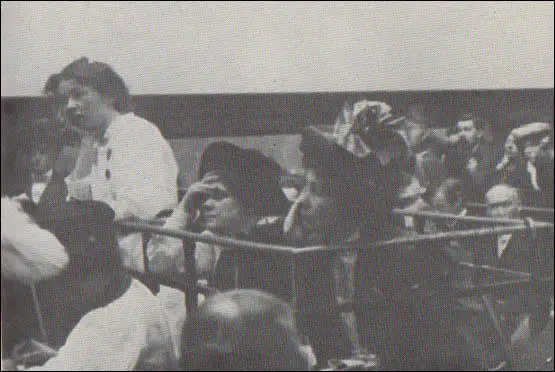
In November 1909, Theresa Garnett accosted Winston Churchill with a whip. She shouted "take that you brute", however, she later admitted she missed him. She was arrested for assault but was found guilty of disturbing the peace. Garnett was found guilty and was sentenced to a month's imprisonment in Horfield Prison. Her friend, Mary Blathwayt, wrote in her diary on 15th November: "Miss Garnett got one month for whipping Mr. Churchill across the face and not hurting him." The following day, her mother, Emily Blathwayt, wrote: The papers were full of Saint Theresa as we call her." Emily went onto say that the movement was "not altogether displeased" that the newspapers had headlines that were not true such as "Winston whipped" and "Churchill flogged". (28)
The Conciliation Bill
In January 1910, Herbert Asquith called a general election in order to obtain a new mandate. However, the Liberals lost votes and was forced to rely on the support of the 42 Labour Party MPs to govern. Henry Brailsford, a member of the Men's League For Women's Suffrage wrote to Millicent Fawcett, suggesting that he should attempt to establish a Conciliation Committee for Women's Suffrage. "My idea is that it should undertake the necessary diplomatic work of promoting an early settlement". (29)
Emmeline Pankhurst and Millicent Fawcett both agreed to the idea and the WSPU declared a truce in which all militant activities would cease until the fate of the Conciliation Bill was clear. A Conciliation Committee, composed of 36 MPs (25 Liberals, 17 Conservatives, 6 Labour and 6 Irish Nationalists) all in favour of some sort of women's enfranchisement, was formed and drafted a Bill which would have enfranchised only a million women but which would, they hoped, gain the support of all but the most dedicated anti-suffragists. (30) Fawcett wrote that "personally many suffragists would prefer a less restricted measure, but the immense importance and gain to our movement is getting the most effective of all the existing franchises thrown upon to woman cannot be exaggerated." (31)
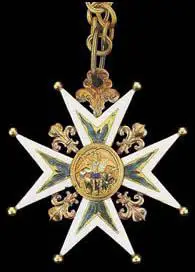
The Conciliation Bill was designed to conciliate the suffragist movement by giving a limited number of women the vote, according to their property holdings and marital status. After a two-day debate in July 1910, the Conciliation Bill was carried by 109 votes and it was agreed to send it away to be amended by a House of Commons committee. Asquith made a speech where he made it clear that he intended to shelve the Conciliation Bill.
On hearing the news, Emmeline Pankhurst, led 300 women from a pre-arranged meeting at the Caxton Hall to the House of Commons on 18th November, 1910. Sylvia Pankhurst was one of the women who took part in the protest and experienced the violent way the police dealt with the women: "I saw Ada Wright knocked down a dozen times in succession. A tall man with a silk hat fought to protect her as she lay on the ground, but a group of policemen thrust him away, seized her again, hurled her into the crowd and felled her again as she turned. Later I saw her lying against the wall of the House of Lords, with a group of anxious women kneeling round her. Two girls with linked arms were being dragged about by two uniformed policemen. One of a group of officers in plain clothes ran up and kicked one of the girls, whilst the others laughed and jeered at her." (32)
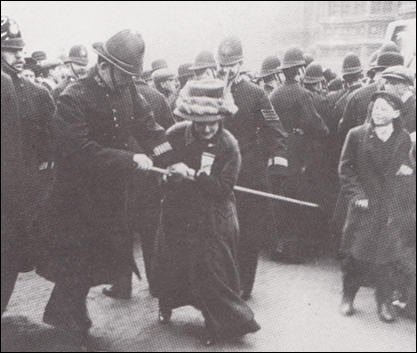
Henry Brailsford was commissioned to write a report on the way that the police dealt with the demonstration. He took testimony from a large number of women, including Mary Frances Earl: "In the struggle the police were most brutal and indecent. They deliberately tore my undergarments, using the most foul language - such language as I could not repeat. They seized me by the hair and forced me up the steps on my knees, refusing to allow me to regain my footing... The police, I understand, were brought specially from Whitechapel." (32a)
Paul Foot, the author of The Vote (2005) has pointed out, Brailsford and his committee obtained "enough irrefutable testimony not just of brutality by the police but also of indecent assault - now becoming a common practice among police officers - to shock many newspaper editors, and the report was published widely". (32b) However, Edward Henry, the Commissioner of the Metropolitan Police, claimed that the sexual assaults were committed by members of the public: "Amongst this crowd were many undesirable and reckless persons quite capable of indulging in gross conduct." (32c)
A new Conciliation Bill was passed by the House of Commons on 5th May 1911 with a majority of 167. The main opposition came from Winston Churchill, the Home Secretary, who saw it as being "anti-democratic". He argued "Of the 18,000 women voters it is calculated that 90,000 are working women, earning their living. What about the other half? The basic principle of the Bill is to deny votes to those who are upon the whole the best of their sex. We are asked by the Bill to defend the proposition that a spinster of means living in the interest of man-made capital is to have a vote, and the working man's wife is to be denied a vote even if she is a wage-earner and a wife." (33)
David Lloyd George, the Chancellor of the Exchequer, was officially in favour of woman's suffrage. However, he had told his close associates, such as Charles Masterman, the Liberal MP in West Ham North: "He (David Lloyd George) was very much disturbed about the Conciliation Bill, of which he highly disapproved although he is a universal suffragist... We had promised a week (or more) for its full discussion. Again and again he cursed that promise. He could not see how we could get out of it, yet he regarded it as fatal (if passed)." (34)
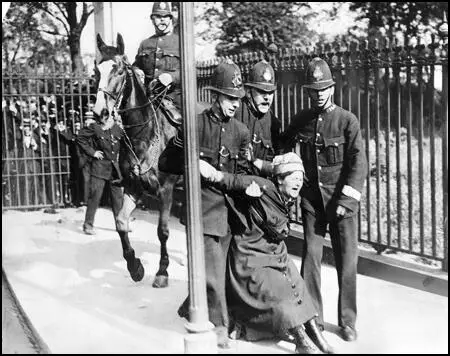
Lloyd George was convinced that the chief effect of the Bill, if it became law, would be to hand more votes to the Conservative Party. During the debate on the Conciliation Bill he stated that justice and political necessity argued against enfranchising women of property but denying the vote to the working class. The following day Herbert Asquith announced that in the next session of Parliament he would introduce a Bill to enfranchise the four million men currently excluded from voting and suggested it could be amended to include women. Paul Foot has pointed out that as the Tories were against universal suffrage, the new Bill "smashed the fragile alliance between pro-suffrage Liberals and Tories that had been built on the Conciliation Bill." (35)
Millicent Fawcett still believed in the good faith of the Asquith government. However, the WSPU, reacted very differently: "Emmeline and Christabel Pankhurst had invested a good deal of capital in the Conciliation Bill and had prepared themselves for the triumph which a women-only bill would entail. A general reform bill would have deprived them of some, at least, of the glory, for even though it seemed likely to give the vote to far more women, this was incidental to its main purpose." (36)
Christabel Pankhurst wrote in Votes for Women that Lloyd George's proposal to give votes to seven million instead of one million women was, she said, intended "not, as he professes, to secure to women a larger measure of enfranchisement but to prevent women from having the vote at all" because it would be impossible to get the legislation passed by Parliament. (37)
On 21st November, the WSPU carried out an "official" window smash along Whitehall and Fleet Street. This involved the offices of the Daily Mail and the Daily News and the official residences or homes of leading Liberal politicians, H. H. Asquith, David Lloyd George, Winston Churchill, Edward Grey, John Burns and Lewis Harcourt. It was reported that "160 suffragettes were arrested, but all except those charged with window-breaking or assault were discharged." (38)
The following month Millicent Fawcett wrote to her sister, Elizabeth Garrett: "We have the best chance of Women's Suffrage next session that we have ever had, by far, if it is not destroyed by disgusting masses of people by revolutionary violence." Elizabeth agreed and replied: "I am quite with you about the WSPU. I think they are quite wrong. I wrote to Miss Pankhurst... I have now told her I can go no more with them." (39)
Henry Brailsford went to see the Emmeline Pankhurst and asked her to control her members in order to get the legislation passed by Parliament. She replied "I wish I had never heard of that abominable Conciliation Bill!" and Christabel Pankhurst called for more militant actions. The Conciliation Bill was debated in March 1912, and was defeated by 14 votes. Asquith claimed that the reason why his government did not back the issue was because they were committed to a full franchise reform bill. However, he never kept his promise and a new bill never appeared before Parliament. (40)
Arson Campaign
Some members of the WSPU, including Adela Pankhurst became concerned about the increase in the violence as a strategy. She later told fellow member, Helen Fraser: "I knew all too well that after 1910 we were rapidly losing ground. I even tried to tell Christabel this was the case, but unfortunately she took it amiss." After arguing with Emmeline Pankhurst about this issue she left the WSPU in October 1911. Sylvia Pankhurst was also critical of this new militancy. (41)
Margery Corbett was a member of the NUWSS when she met Emmeline and Sylvia in 1911. "I talked to Emmeline Pankhurst and her daughter Sylvia. I admired their wonderful courage, but when they started hurting other people, I had to decide whether I wanted to go on working with the constitutional movement, or whether I would join the militants. Eventually I decided to remain a constitutional." (42)
On 4th March 1912 the Women's Social & Political Union (WSPU) organised a window-breaking demonstration in Whitehall. Frederick Pethick-Lawrence and Emmeline Pethick-Lawrence both disagreed with this strategy but Christabel Pankhurst ignored their objections. Records seized as evidence show the imtvitation sent out by Emmeline Pankhurst: "Men and women I invite you to come to Parliament Square on Monday, March 4th 1912 at 8 o'clock to take part in a 'Great Protest Meeting' against the government's refusal to include women in their reform Bill. Speeches will be delivered by well-known Suffragettes, who want to enlist your sympathy and help in the great battle they are fighting for human liberty." This vaguely-titled ‘Great Militant Protest' was a "skilfully planned secret attack" that would involve over 150 women armed with hammers, stones and clubs simultaneously smashing the windows of shops and offices in London's West End.
Victoria Lidiard from Bristol was one of the women who volunteered to take part in the demonstration. The severely disabled, May Billinghurst, agreed to hide some of the stones underneath the rug covering her knees. According to Votes for Women: "From in front, behind, from every side it came - a hammering, crashing, splintering sound unheard in the annals of shopping... At the windows excited crowds collected, shouting, gesticulating. At the centre of each crowd stood a woman, pale, calm and silent."
Victoria broke a window at the War Office. She later recalled: "He just looked at me. Meantime another policeman rushed up towards me and then an inspector on horseback came. So I was escorted to Bow Street, a policeman each side of me, clutching my arm. and one behind. Well, I had eight stones, but I'd only used one so on the way to the police station I dropped them one by one and to my amazement when I was taken down at Bow Street, this policeman that had followed put the seven stones on the table and said, She dropped these on the way." Victoria was one of 200 suffragettes who was arrested and jailed for taking part in the demonstration.
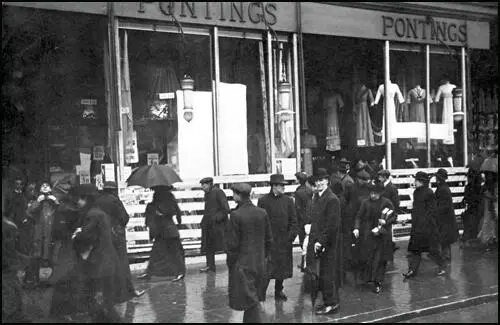
by Women's Social & Political Union members (4th March, 1912)
Victoria Lidiard got two months. Bella Hoffman has pointed out: "Her memory of Holloway was of one of her own sisters shouting encouraging messages from across the street, standing on a chair in her cell and singing out of the barred window, and the black beetle in her porridge." Under instructions from her mother, Victoria did not go on hunger-strike. As she later pointed out in a BBC interview, although she was willing to go to prison for women's suffrage, she was unable to disobey an order given by her mother.
The government ordered the arrest of the leaders of the WSPU. Christabel Pankhurst escaped to France but Frederick Pethick-Lawrence and Emmeline Pethick-Lawrence were arrested, tried and sentenced to nine months imprisonment. They were also successfully sued for the cost of the damage caused by the WSPU. (43)
Frederick Pethhick Lawrence was made to suffer force-feeding twice a day for ten days before his release: "The head doctor, a most sensitive man, was visibly distressed by what he had to do. It certainly was an unpleasant and painful process and a sufficient number of warders had to be called in to prevent my moving while a rubber tube was pushed up my nostril and down into my throat and liquid was poured through it into my stomach. Twice a day thereafter one of the doctors fed me in this way. I was not allowed to leave my cell in the hospital and for the most part I had to stay in bed. There was nothing to do but to read; and the days were very long and went very slowly." (44)
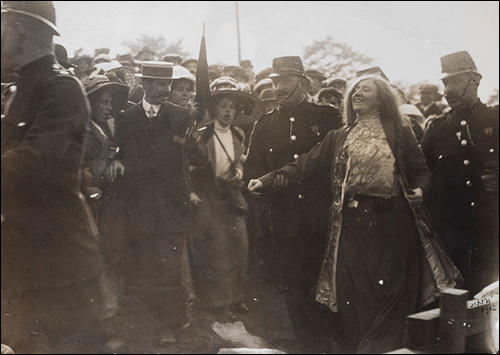
Emmeline Pankhurst was one of those arrested. Once again she went on hunger strike: "I generally suffer most on the second day. After that there is no very desperate craving for food. weakness and mental depression take its place. Great disturbances of digestion divert the desire for food to a longing for relief from pain. Often there is intense headache, with fits of dizziness, or slight delirium. Complete exhaustion and a feeling of isolation from earth mark the final stages of the ordeal. Recovery is often protracted, and entire recovery of normal health is sometimes discouragingly slow." After she was released from prison she was nursed by Catherine Pine. (45)
Emmeline Pankhurst gave permission for her daughter, Christabel Pankhurst, to launch a secret arson campaign. She knew that she was likely to be arrested and so she decided to move to Paris. Attempts were made by suffragettes to burn down the houses of two members of the government who opposed women having the vote. These attempts failed but soon afterwards, a house being built for David Lloyd George, the Chancellor of the Exchequer, was badly damaged by suffragettes. (46)
Annie Kenney was put in charge of the WSPU in London. Every week Kenney travelled to France to receive Christabel's latest orders. Fran Abrams has pointed out: "It was the start of a cloak-and-dagger existence that lasted for more than two years. Each Friday, heavily disguised, Annie would take the boat-train via La Havre. Sundays were devoted to work but on Saturdays the two would walk along the Seine or visit the Bois de Boulogne. Annie took instructions from Christabel on every little point - which organiser should be placed where, circular letters, fund-raising, lobbying MPs... During the week Annie worked all day at the union's Clement's Inn headquarters, then met militants at her flat at midnight to discuss illegal actions. Christabel had ordered an escalation of militancy, including the burning of empty houses, and it fell to Annie to organise these raids. She did not enjoy this work, nor did she agree with it. She did it because Christabel asked her to, she said later." (47)
Christabel was aware that after the House of Lords had rejected the proposed 1831 Reform Act, a mob had attempted to burn down Nottingham Castle. She therefore asked Sylvia Pankhurst to carry out a similar attack. Sylvia later wrote: "The idea of doing a stealthy deed of destruction was repugnant... Though I knew she did not consider it so, I had the unhappy sense of having been asked to do something morally wrong. I replied that I should be willing to lead a torchlight procession to the castle, to fling my torch at it, and to call the others to do the same, as a symbolic act." Christabel was unimpressed and rejected the idea. (48)
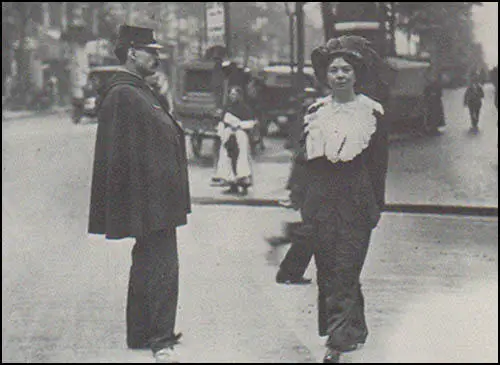
At a meeting in France, Christabel Pankhurst told Frederick Pethick-Lawrence and Emmeline Pethick-Lawrence about the proposed arson campaign. When they objected, Christabel arranged for them to be expelled from the the organisation. Emmeline later recalled in her autobiography, My Part in a Changing World (1938): "My husband and I were not prepared to accept this decision as final. We felt that Christabel, who had lived for so many years with us in closest intimacy, could not be party to it. But when we met again to go further into the question… Christabel made it quite clear that she had no further use for us." (49)
One of the first arsonists was Mary Richardson. She later recalled the first time she set fire to a building: "I took the things from her and went on to the mansion. The putty of one of the ground-floor windows was old and broke away easily, and I had soon knocked out a large pane of the glass. When I climbed inside into the blackness it was a horrible moment. The place was frighteningly strange and pitch dark, smelling of damp and decay... A ghastly fear took possession of me; and, when my face wiped against a cobweb, I was momentarily stiff with fright. But I knew how to lay a fire - I had built many a camp fire in my young days -a nd that part of the work was simple and quickly done. I poured the inflammable liquid over everything; then I made a long fuse of twisted cotton wool, soaking that too as I unwound it and slowly made my way back to the window at which I had entered." (50)
Annie Kenney was charged with "incitement to riot" in April 1913. She was found guilty at the Old Bailey and was sentenced to eighteen months in Maidstone Prison. Her deputy, Grace Roe, now became head of operations in London. She immediately went on hunger strike and became the first suffragette to be released under the provisions of the Cat and Mouse Act. Kenney went into hiding until she was caught once again and returned to prison. That summer she escaped to France during a respite and went to live with Christabel Pankhurst in Deauville. (51)
Christabel Pankhurst remained convinced that escalating violence would eventually win the parliamentary vote for women since it would create, she believed, an intolerable situation for politicians. In early January 1914, she asked Sylvia to travel to Paris where she told her that her East London Federation must be separate from the WSPU since it was allied to the socialist movement. (52)
Sylvia was also criticised for speaking on the same platform as the Labour Party MP, George Lansbury. Christabel told her: "You have your own ideas. We do not want that; we want all our women to take their instructions and walk in step like an army!" Sylvia later recalled: "Too tired, too ill to argue, I made no reply. I was oppressed by a sense of tragedy, grieved by her ruthlessness. Her glorification of autocracy seemed to me remote from the struggle we were waging." (53)
Christabel also told her sister that she must withdraw support from the Labour Party. She had now decided that the WSPU should not form any alliance with male politicians. Christabel wrote in The Suffragette: "For Suffragists to put their faith in any men's party, whatever it may call itself, is recklessly to disregard the lessons of the past forty years… The truth is that women must work out their own salvation. Men will not do it for them". (54)
Emmeline Pankhurst was now estranged from two of her daughters. Emmeline Pethick-Lawrence wrote to Sylvia Pankhurst about her mother: "I believe she conceived her objective in the spirit of generous enthusiasm. In the end it obsessed her like a passion and she completely identified her own career with it in order to obtain it. She threw scruple, affection, honour, legality and her own principles to the winds." (55)
Ramsay MacDonald, the leader of the Labour Party, had argued for many years that women's suffrage was a necessary part of a socialist programme. However, MacDonald rejected the WSPU use of violence: "I have no objection to revolution, if it is necessary but I have the very strongest objection to childishness masquerading as revolution, and all that one can say of these window-breaking expeditions is that they are simply silly and provocative. I wish the working women of the country who really care for the vote ... would come to London and tell these pettifogging middle-class damsels who are going out with little hammers in their muffs that if they do not go home they will get their heads broken." (56)
In 1912 the WSPU began a campaign to destroy the contents of pillar-boxes. By December, the government claimed that over 5,000 letters had been damaged by the WSPU. The main figure in this campaign was May Billinghurst. A fellow suffragette, Lilian Lenton, argued: "She (May Billinghurst) would set out in her chair with many little packages from which, when they were turned upside down, there flowed a dark brown sticky fluid, concealed under the rug which covered her legs. She went undeviatingly from one pillar box to another, sometimes alone, sometimes with another suffragette to do the actual job, dropping a package into each one." (57)
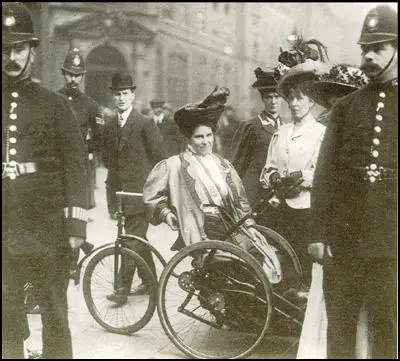
Billinghurst was eventually arrested at Blackheath preparing for a pillar-box raid. She seemed pleased about being caught as she told the police officer: "With all the pillar boxes we've done, there has been nothing in the papers about it - perhaps now there has been an arrest there will be something." Billinghurst appeared at the Old Bailey in January 1913. During the trial Billinghurst argued: "The government authorities may further maim my body by the torture of forcible feeding as they are torturing weak women in prison at the present time. They may even kill me in the process for I am not strong, but they cannot take away my freedom of spirit or my determination to fight this good fight to the end." (58)
In January 1913, Emmeline Pankhurst made a speech where she stated that it was now clear that Herbert Asquith had no intention to introduce legislation that would give women the vote. She now declared war on the government and took full responsibility for all acts of militancy. "Over the next eighteen months, the WSPU was increasingly driven underground as it engaged in destruction of property, including setting fire to pillar boxes, raising false fire alarms, arson and bombing, attacking art treasures, large-scale window smashing campaigns, the cutting of telegraph and telephone wires, and damaging golf courses". (59)
The women responsible for these arson attacks were often caught and once in prison they went on hunger-strike. Determined to avoid these women becoming martyrs, the government introduced the Prisoner's Temporary Discharge of Ill Health Act. Suffragettes were now allowed to go on hunger strike but as soon as they became ill they were released. Once the women had recovered, the police re-arrested them and returned them to prison where they completed their sentences. This successful means of dealing with hunger strikes became known as the Cat and Mouse Act. (60)
On 24th February 1913, Emmeline Pankhurst was arrested for procuring and inciting persons to commit offences contrary to the Malicious Injuries to Property Act 1861. The Times reported: "Mrs Pankhurst, who conducted her own defence, was found guilty, with a strong recommendation to mercy, and Mr Justice Lush sentenced her to three years' penal servitude. She had previously declared her intention to resist strenuously the prison treatment until she was released. A scene of uproar followed the passing of the sentence." (61)
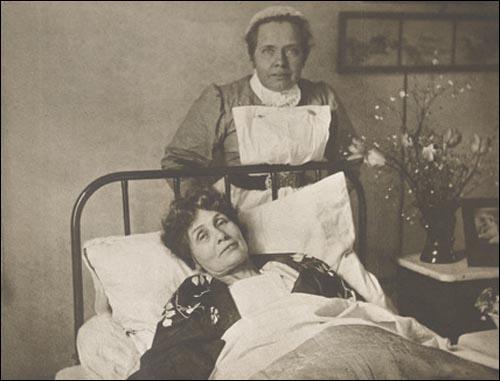
After going nine days without eating, they released her for fifteen days so she could recover her health. "They sent me away, sitting bolt upright in a cab, unmindful of the fact that I was in a dangerous condition of weakness, having lost two stone in weight and suffered seriously from irregularities of heart action." On 26th May, 1913, when Emmeline Pankhurst attempted to attend a meeting, she was arrested and returned to prison. (62)
Rachel Barrett and other members of staff were arrested while printing The Suffragette newspaper. Found guilty of conspiracy she was sentenced to nine months imprisonment. She immediately began a hunger strike in Holloway Prison. After five days she was released under the Cat and Mouse Act. Barrett was re-arrested and this time went on a hunger and thirst strike. When she was released she escaped to Edinburgh. After a meeting with Christabel Pankhurst in Paris, it was decided to publish the newspaper in Scotland. (63)
In June, 1913, at the most important race of the year, the Derby, Emily Davison ran out on the course and attempted to grab the bridle of Anmer, a horse owned by King George V. The horse hit Emily and the impact fractured her skull and she died without regaining consciousness. Although many suffragettes endangered their lives by hunger strikes, Emily Davison was the only one who deliberately risked death. However, her actions did not have the desired impact on the general public. They appeared to be more concerned with the health of the horse and jockey and Davison was condemned as a mentally ill fanatic. (64)
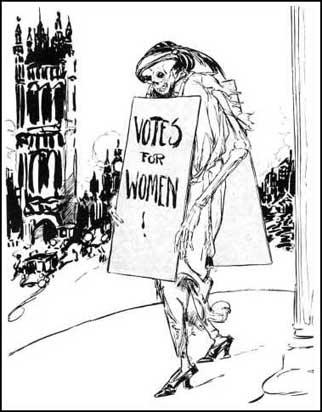
During this period Kitty Marion was the leading figure in the WSPU arson campaign and she was responsible for setting fire to Levetleigh House at St Leonards (April 1913), the Grandstand at Hurst Park racecourse (June 1913) and various houses in Liverpool (August, 1913) and Manchester (November, 1913). These incidents resulted in a series of further terms of imprisonment during which force-feeding occurred followed by release under the Cat & Mouse Act. It has been calculated that Marion endured 200 force-feedings in prison while on hunger strike. (65)
The Great Scourge
Sylvia Pankhurst became increasing disillusioned with Christabel's approach to the suffrage campaign. "Votes for women and chastity for men became her favourite slogan... She alleged that seventy-five to eighty per cent of men become infected with gonorrhea, and twenty to twenty-five per cent with syphilis, insisting that only an insignificant minority escaped infection by some form of venereal disease. Women were strongly warned against the dangers of marriage, and assured that large numbers of women were refusing it. The greater part, both of the serious and minor illnesses suffered by married women... she declared to be due to the husband having at some time contracted gonorrhea Childless marriages were attributed to the same cause. Syphilis she declared to be the prime reason of a high infantile mortality." (66)
Christabel Pankhurst wrote several articles in The Suffragette on the dangers of marriage. Christabel's articles were reissued as a book entitled, The Great Scourge and How to End It (1913). She argued that most men had venereal disease and that the prime reason for opposition to women's suffrage came from men concerned that enfranchised women would stop their promiscuity. Until they had the vote, she suggested that women should be wary of any sexual contact with men. (67)
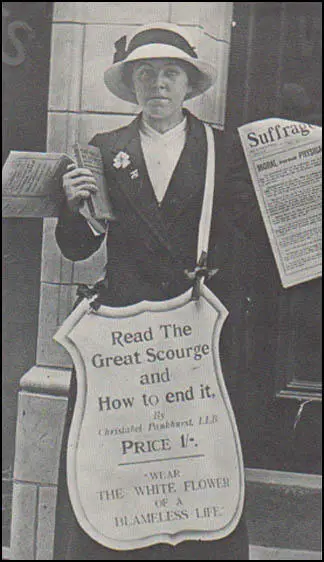
Dora Marsden criticised Christabel Pankhurst for upholding the values of chastity, marriage and monogamy. She also pointed out in The Egoist that Pankhurst's statistics on venereal disease were so exaggerated that they made nonsense of her argument. Marsden concluded the article with the claim: "If Miss Pankhurst desires to exploit human boredom and the ravages of dirt she will require to call in the aid of a more subtle intelligence than she herself appears to possess." (68) Other contributors to the journal joined in the attack on Pankhurst. Dora Foster Kerr argued that "her obvious ignorance of life is a great handicap to Miss Pankhurst". (69) Whereas Ezra Pound suggested that she "has as much intellect as a guinea pig" (70).
Rebecca West, a leading feminist and suffrage campaigner, was also appalled by Christabel's views on sex. "I say that her remarks on the subject are utterly valueless and are likely to discredit the Cause in which we believe... The strange uses to which we put our new-found liberty! There was a long and desperate struggle before it became possible for women to write candidly on subjects such as these. That this power should be used to express views that would be old-fashioned and uncharitable in the pastor of a Little Bethel is a matter for scalding tears." (71)
Decline of the WSPU
Several friends became worried about Christabel's mental state. A number of significant figures in the WSPU left the organisation over the arson campaign. This included Elizabeth Robins, Jane Brailsford, Laura Ainsworth, Eveline Haverfield and Louisa Garrett Anderson. Leaders of the Men's League For Women's Suffrage such as Henry N. Brailsford, Henry Nevinson and Laurence Housman, argued "that militancy had been taken to foolish extremes and was now damaging the cause". (72)
Hertha Ayrton, Lilias Ashworth Hallett, Janie Allan and Elizabeth Garrett Anderson stopped providing much needed money for the organization. Colonel Linley Blathwayt and Emily Blathwayt also cut off funds to the WSPU. In June 1913 a house had been burned down close to Eagle House. Under pressure from her parents, Mary Blathwayt resigned from the WSPU. (73)
In February 1914, Christabel expelled Sylvia Pankhurst and Adela Pankhurst from the WSPU for refusing to follow orders. Beatrice Harraden, a member of the WSPU since 1905, wrote a letter to Christabel calling on her to bring an end to the arson campaign and accusing her of alienating too many old colleagues by her dictatorial behaviour: "It must be that... your exile (in Paris) prevents you from being in real touch with facts as they are over here." (74)
Henry Harben complained that her autocratic behaviour had destroyed the WSPU: "People are saying that from the leader of a great movement you are developing into the ringleader of a little rebel Rump." (75) According to Martin Pugh "she had fallen into the error of all autocratic leaders; her power to manipulate personnel was so complete that it left her increasingly surrounded by sycophants who lacked real ability." (76)
On 10 March 1914 Mary Richardson attacked a painting, Rokeby Venus by Diego Velázquez at the National Gallery. She later described what happened: "I dashed up to the painting. My first blow with the axe merely broke the protective glass. But, Of course, it did more than that, for the detective rose with his newspaper still in his hand and walked round the red plush seat, staring up at the skylight which was being repaired. The sound of the glass breaking also attracted the attention of the attendant at the door who, in his frantic efforts to reach me, slipped on the highly polished floor and fell face downward. And so I was given time to get in a further four blows with my axe before I was, in turn, attacked." (77)
The Manchester Guardian reported the following day: "At the National Gallery, yesterday morning, the famous Rokeby Venus, the Velasquez picture which eight years ago was bought for the nation by public subscription for £45,000, was seriously damaged by a militant suffragist connected with the Women's Social and Political Union... The woman, producing a meat chopper from her muff or cloak, smashed the glass of the picture, and rained blows upon the back of the Venus. A police officer was at the door of the room, and a gallery attendant also heard the smashing of the glass. They rushed towards the woman, but before they could seize her she had made seven cuts in the canvas. (78)
First World War
The British government declared war on Germany on 4th August 1914. Two days later, Millicent Fawcett, the leader of the NUWSS declared that the organization was suspending all political activity until the conflict was over. Fawcett supported the war effort but she refused to become involved in persuading young men to join the armed forces. This WSPU took a different view to the war. It was a spent force with very few active members. According to Martin Pugh, the WSPU were aware "that their campaign had been no more successful in winning the vote than that of the non-militants whom they so freely derided". (79)
The WSPU carried out secret negotiations with the government and on the 10th August the government announced it was releasing all suffragettes from prison. In return, the WSPU agreed to end their militant activities and help the war effort. Christabel Pankhurst, arrived back in England after living in exile in Paris. She told the press: "I feel that my duty lies in England now, and I have come back. The British citizenship for which we suffragettes have been fighting is now in jeopardy." (80)
After receiving a £2,000 grant from the government, the WSPU organised a demonstration in London. Members carried banners with slogans such as "We Demand the Right to Serve", "For Men Must Fight and Women Must Work" and "Let None Be Kaiser's Cat's Paws". At the meeting, attended by 30,000 people, Emmeline Pankhurst called on trade unions to let women work in those industries traditionally dominated by men. She told the audience: "What would be the good of a vote without a country to vote in!". (81)
In October 1915, The WSPU changed its newspaper's name from The Suffragette to Britannia. Emmeline's patriotic view of the war was reflected in the paper's new slogan: "For King, For Country, for Freedom'. The newspaper attacked politicians and military leaders for not doing enough to win the war. In one article, Christabel Pankhurst accused Sir William Robertson, Chief of Imperial General Staff, of being "the tool and accomplice of the traitors, Grey, Asquith and Cecil". Christabel demanded the "internment of all people of enemy race, men and women, young and old, found on these shores, and for a more complete and ruthless enforcement of the blockade of enemy and neutral." (82)
Anti-war activists such as Ramsay MacDonald were attacked as being "more German than the Germans". Another article on the Union of Democratic Control carried the headline: "Norman Angell: Is He Working for Germany?" Mary Macarthur and Margaret Bondfield were described as "Bolshevik women trade union leaders" and Arthur Henderson, who was in favour of a negotiated peace with Germany, was accused of being in the pay of the Central Powers. Her daughter, Sylvia Pankhurst, who was now a member of the Labour Party, accused her mother of abandoning the pacifist views of Richard Pankhurst. (83)
Adela Pankhurst also disagreed with her mother and in Australia she joined the campaign against the First World War. Adela believed that her actions were true to her father's belief in international socialism. She wrote to Sylvia that like her she was "carrying out her father's work". Emmeline Pankhurst completely rejected this approach and told Sylvia that she was "ashamed to know where you and Adela stand." (84) Sylvia commented: "Families which remain on unruffled terms, though their members are in opposing political parties, take their politics less keenly to heart than we Pankhursts." (85)
On 28th March, 1917, the House of Commons voted 341 to 62 that women over the age of 30 who were householders, the wives of householders, occupiers of property with an annual rent of £5 or graduates of British universities. MPs rejected the idea of granting the vote to women on the same terms as men. Lilian Lenton, who had played an important role in the militant campaign later recalled: "Personally, I didn't vote for a long time, because I hadn't either a husband or furniture, although I was over 30." (86)
Emmeline Pankhurst and Christabel Pankhurst now dissolved the Women's Social & Political Union and formed The Women's Party. Its twelve-point programme included: (i) A fight to the finish with Germany. (ii) More vigorous war measures to include drastic food rationing, more communal kitchens to reduce waste, and the closing down of nonessential industries to release labour for work on the land and in the factories. (iii) A clean sweep of all officials of enemy blood or connections from Government departments. Stringent peace terms to include the dismemberment of the Hapsburg Empire." (87)
Primary Sources
(1) Emmeline Pankhurst described the formation of the Women's Social and Political Union in her book My Own Story (1914).
It was on October 10, 1903 that I invited a number of women to my house in Nelson Street, Manchester, for purposes of organisation. We voted to call our new society the Women's Social and Political Union, partly to emphasize its democracy, and partly to define its object as political rather than propagandist. We resolved to limit our membership exclusively to women, to keep ourselves absolutely free from party affiliation, and to be satisfied with nothing but action on our question. "Deeds, not Words" was to be our permanent motto.
(2) Margaret Haig Thomas, This Was My World (1933)
I was determined to join the Pankhursts' organisation, the Women's Social and Political Union, but was held up in this resolve for three months by the fact that my father, who had considerable foresight and realised pretty well what joining that body was likely to mean, was inclined to be opposed to the idea. However, I finally decided that he could be no judge of a matter which concerned one primarily as a woman. Prid meanwhile had, travelling by a slightly different road, arrived at the same conclusion. She and I met one autumn day in London, and, full of excitement, went off together to Clement's Inn and joined.
(3) Emmeline Pankhurst, My Own Story (1914)
The Women's Social and Political Union had been in existence two years before any opportunity was presented to work on a national scale. The autumn of 1905 brought a political situation, which seemed to us to promise bright hopes for women's enfranchisement. The life of the old Parliament was coming to an end, and the country was on the eve of a general election in which the liberals hoped to be returned to power… The only object worth trying for was pledges from responsible leaders that the new Government would make women's suffrage a part of the official programme.
(4) William Stead, The Review of Reviews (November, 1906)
A deputation from the Woman's Social and Political Union waited upon the Prime Minister to urge upon him the importance of conceding the vote to women. As Sir Henry refused to do anything, a few of the more determined leaders of the movement made a demonstration in the outer Lobby. It was a very harmless affair. A few sentences of indignant protest, promptly cut short by the police, fell from the lips of the first speaker. Mrs. Despard, sister of General French, a grey-haired matron who has devoted herself to charitable works in South West London, promptly took the place of the silenced speaker, only to be as promptly silenced. The police then removed the protesting ladies, and there the incident ought to have ended. But no sooner were the women removed from the precincts of Parliament than several of them were arrested, including at least one bystander, Miss Annie Kenney, who had never been in the Lobby at all, and who had refrained from taking any part in the demonstration. Mrs. Despard, who was one of the chief offenders, protested against Miss Kenney's arrest, declaring that if any one deserved arrest it was herself. The police, however, refrained from arresting General French's sister, saying that they had their instructions. So Miss Kenney, the factory girl was marched off to prison, while Mrs. Despard was left at liberty, in order apparently to demonstrate that even in dealing with women there is one law for the rich and another for the poor.
Next day the ladies were brought before the Westminster police magistrate. They were not represented by counsel, and they one and all declared that they ignored the jurisdiction of the Court. They regarded themselves as outlaws, shut out from the pale of the Constitution. Several persons who had witnessed the proceedings tendered themselves as voluntary witnesses, but they were not allowed to give their evidence. The police, therefore, had everything their own way, and the magistrate convicted the whole batch, ordering them to enter into recognizances and bind themselves over to keep the peace for six months. As they refused to do anything of the kind they were ordered to be imprisoned as ordinary criminal convicts for two months. One of the Misses Pankhurst, who was accused of attempting to make a disturbance outside the Court, was sentenced to a fortnight's imprisonment on the evidence of the police, which was flatly contradicted by three independent respectable witnesses. The prisoners were then removed from Court and conveyed in Black Maria to Holloway Gaol. The most disreputable feature of the proceedings was the deliberate and malignant misrepresentation of the conduct of the accused by the hooligans of some of the daily papers. The cowardly brutality of some of the scoundrels who lend their pens to this campaign of calumny is a melancholy illustration of the extent to which some newspapers are staffed by Yahoos.
The ladies, on arriving at Holloway Gaol, were treated exactly as if they had been the drabs of the street convicted for drunkenness. They were stripped, deprived of their own raiment, made to wear the clothes, none too clean, of previous prisoners, and shut up in verminous cells in solitary confinement. Two of their number, Mrs. Pethwick-Lawrence, the wife of the last proprietor of the Echo, and Mrs. Montefiore, broke down in health. To avert fatal consequences their medical advisers insisted that they should enter into recognizances for good behaviour and regain their liberty. One of the others who was ill was sent into the hospital. The others, among them Mrs. Cobden-Saunderson, a daughter Richard Cobden, stood firm and took their gruel without complaint. They were prepared to "stick it through" to the end. Neither they nor any of their representatives made any appeal to the Government for any amelioration of their condition. They protested vigorously to the Governor against the filthy state of their cells. Tardy measures were taken to extirpate the bugs from which less distinguished prisoners have long suffered, but they were less successful in their protests against the rats and mice. When I was at Holloway as a first-class misdemeanant twenty years ago, one of my liveliest recollections is that of mice running over my head as I lay in bed. Things do not appear to have improved much since then.
(5) William Stead, The Review of Reviews (June, 1910)
Saturday, June 18th, promises to be a memorable day in the history of Woman's Suffrage. Since the General Election the militants have postponed the threatened resumption of warlike tactics in order to give a fair opportunity to the tactics of ordinary peaceful, law-abiding demonstration. They are as keen as ever for admission within the pale of the Constitution, but they have been told that after 480 of their number have proved the sincerity of their enthusiasm by going to gaol there is no need now for anything more sensational than a great procession through the streets of London and a united demonstration in Albert Hall. Although the older, not to say the ancient, Union which bore the burden and heat of the day before the advent of the Suffragettes is not to be officially represented in the procession - much to our regret - most of their members will probably be in the ranks. This is emphatically an occasion on which all advocates for woman's emancipation should sink their differences and present a united front to the enemy. I sincerely hope that all my Helpers and Associates who may be in town will not fail to fall into line and spare no effort to make the procession of June 18th one of those memorable demonstrations of political earnestness which leave an indelible impression on the public mind. That the Women will obtain enfranchisement in this Parliament I do not venture to hope. But the days of the present Parliament are numbered, and the prospects of success in the next will largely depend on the impression of orderly, well-disciplined enthusiasm which London will receive from this midsummer procession.
(6) Christabel Pankhurst, Unshackled (1959)
Miss Wallace Dunlop, taking counsel with no one and acting entirely on her own initiative, sent to the Home Secretary, Mr. Gladstone, as soon as she entered Holloway Prison, an application to be placed in the first division as befitted one charged with a political offence. She announced that she would eat no food until this right was conceded. Mr. Gladstone did not reply, but after she had fasted ninety-one hours, Miss Wallace Dunlop was set free. She was in an exhausted state, having refused every threat and appeal to induce her to break her fast.
(7) Teresa Billington Greig, The Non-Violent Militant (1987)
The first militant protest was decided upon by Miss Christabel Pankhurst, and announced by mother or daughter to a small number of the more active members of the Union. The body of members knew nothing of the plans until they heard with the public that it had been carried out… It was at this point that the sense of difference of outlook, of which I had always been conscious in my association with Mrs. Pankhurst and her daughter, became acute. I did not approve the line of protest determined upon. It seemed to me to provide a very inadequate outlet for the expression of our rebellion.
(8) Christabel Pankhurst, Unshackled (1959)
Eighty-one women were still in prison (March, 1912), some for terms of six months… Mother and Mr. and Mrs. Pethick Lawrence went on hunger-strike. The Government retaliated by forcible feeding. This was actually carried out in the case of Mr. and Mrs. Pethick-Lawrence. The doctors and wardresses came to Mother's cell armed with forcible-feeding apparatus. Forewarned by the cries of Mrs. Pethick-Lawrence… Mother received them with all her majestic indignation. They fell back and left her. Neither then nor at any time in her log and dreadful conflict with the government was she forcibly fed.
(9) Dora Montefiore, From a Victorian to a Modern (1927)
The next episode in this eventful year of unavoidable publicity in the women’s cause was the occasion in October, 1906, of our meeting as militant suffragists in the Lobby of the Houses of Parliament with the object of asking the Prime Minister to receive a deputation. It was agreed that if this request was refused several of us should get up on seats and make speeches for “Votes for Women.” Our request was refused, and we began to carry out our subsequent programme. Naturally after the first horror-struck moments of surprise at women daring to voice their wrongs in the very sanctuary of male exclusiveness, the uniformed guardians of the shrine rushed forward to cleanse the sacred spot from such pollution. The women speakers were dragged from their extemporised rostrums and were pushed down the galleries leading from the Lobby towards the Abbey entrance, and with little consideration were spurned down the steps on to the pavement. I was one of those thus ejected. My arm was twisted up against my back by a very strong-muscled policeman, and when I was released at the bottom of the steps of Westminster Hall, and had recovered from the pain of the operation, I turned round and watched the unwilling exit of crowds of other women. At a certain moment in the proceedings I saw Mrs. Despard standing at the top of the steps with a policeman just behind her, and fearing that a woman of her age might be injured by the rough-and-tumble methods which the police, under orders, were executing, I called out to some of the Members and onlookers who were mixed with us women at the foot of the stairs: “Can you men stand by and see a venerable woman handled in the way in which we have just been handled?” I was not allowed to say more, for Inspector Jarvis (who, however. I cannot fail to recall was on many occasions an excellent friend of mine, and who I know was in many respects in sympathy with much of our militant action), remarked to two constables standing near: “Take Mrs. Montefiore in; she is one of the ringleaders.” This “taking me in” meant marching me between two stalwart policemen to Cannon Row police station, where I was placed in a fairly large room and was soon joined by groups of excited and dishevelled militants. This was the beginning, in London, of a form of militancy which I always deprecated, the resistance to the police when being arrested, and struggles with police in the streets. I held that our demonstrations were necessary, and of great use in educating an apathetic public, but for women who are physically weaker than men to pit their strength against police who are trained in the use of physical violence, was derogatory to our sex and useless, if not a hindrance; to the cause for which we stood. When, therefore, some of my younger friends and fellow-workers were pushed into the waiting-room at Cannon Row, with their hair down and often with their clothing torn, I did my best to make them once more presentable, so that we should not appear in the streets as a dishevelled and very excited group of women. I held then, and have never ceased to hold the opinion, that even when demonstrating in the streets or when committing unconventional actions such as speaking in the Lobby of the House, we should always be able to control our voices and our actions and behave as ladies, and that we should gain much more support from the general public by carrying out this line of action. I should like to state here that I personally, except during the Lobby incident, never had to complain of the attitude of the police towards myself. In fact, I often found them helpful and sympathetic, as I shall have occasion later to relate.
After we had all been charged, and while stared at by special police, who were called in to identify us in case of future trouble, we were released on the understanding that we were to appear at the Westminster Court on the following morning. There we found that the charge against us was that of using “violent and abusive language.” Of course, every prisoner must be charged for some definite offence, and as the authorities could not discover that we had committed any of the definite offences in the criminal code, but had only begun to make speeches asking for votes for women, they put down the charge at random as that of “using violent and abusive language.” Each of us was asked in turn what we had to say in answer to the charge, and as I had with me the banner that had hung in front of my house during the “income tax siege,” I held it up first to the Magistrate and then for the Court to see. On it was inscribed: “Women should vote for the laws they obey and the taxes they pay.” A constable snatched the banner from me and the proceedings continued. When the police, being asked for evidence of the breach of the laws which we had committed, were questioned definitely as to what they had heard, they each repeated that we had “asked for votes for women.” Their intellectual equipment was not equal to the task of repeating any of the arguments we had begun to unfold in the Lobby, but “Votes for Women” having by this time become a slogan, they were able to repeat that one sentence, though none of them looked particularly smart or happy as they did so. The proceedings were entirely farcical. The Magistrate consulted with others around him and tried to look very solemn and we were told that we were each to be bound over in the sum of £10 to keep the peace in future. This we all of us refused to do, as we did not consider we had broken the peace, or committed any offence for which we should be bound over. It was then explained to us that the alternative was two months’ imprisonment, and this alternative we accepted. We were once more taken from the Court and shut into a fair-sized room, where we were to be allowed to see friends and relatives, before being taken off to Holloway. As I, with the others, was leaving the Court, I said to the constable who was shepherding us, “I’m sorry to have lost that banner; it hung outside my house during the whole of the Hammersmith siege.” He grinned, but did not appear to be unfriendly, and as we filed into the room within the precincts of the Court, where we had to await “Black Maria,” he pushed the banner into my hands, and said: “It’s all right; here’s your banner.” As my daughter was married and not at the moment in very good health, I did not wish to add to her sufferings on my behalf by sending a summons asking her to come and see me at the Court. My son was working in an engineering business at Rochester and I also wished to save him from more trouble than I realised he was bound to have on my behalf. My brothers and sisters were mostly apathetic about, or hostile to my militant work, so I determined to send for no one of my own relatives, but I was surrounded by many good friends and fellow-workers who had come to give us a word of cheer. Towards evening “Black Maria” arrived at the Court and we were driven off to Holloway. “Black Maria” is a somewhat springless vehicle divided into compartments, so each prisoner is separated, though it is possible to speak to the prisoners immediately around one. It is used for conveying night after night the sweepings of the streets in the shape of drunkards and prostitutes from the Courts where they have been convicted, to Holloway Gaol. It can therefore be understood that it is neither a desirable nor a wholesome vehicle in which to travel. On arrival at Holloway we were each placed in some sort of sentry boxes with seats, and the woman who acted as receiving wardress opened one door after another and took down the details connected with the charge, and the status of the prisoner. She was of decided Irish extraction and the questions she put to us each in succession were to this effect: “Now then, gurrl, stand up! What’s your name, what’s your age, how do you get your livin’?” etc. etc. When all these questions had been answered to the satisfaction of this lady, we were told to leave our compartments and stand in a passage, where we were ordered to strip to our chemises or combinations and then to await further orders. The next scene was taking down our hair and searching rather perfunctorily our heads for possible undesirable inhabitants, after which a prison chemise, made of a sort of sacking, and generously stamped with the broad arrow, was handed to each of us, and I found myself exchanging my warm wool and silk combinations for this decidedly chilly and ungainly garment. The bath ordeal was not serious; we had only to stand in a few inches of doubtful-looking warm water and then put on the various articles of prison clothing provided for us. Each of us had a flannel petticoat made with enormous pleats round the waist, a dress of green serge made on the same ample lines and an apron, a check duster, which we were told was the handkerchief supplied, and a small green cape made with a hood, for out-door exercise, and a white linen cap tied under the chin. Thus arrayed our little party consisting of Mrs. How Martyn, Miss Irene Miller, Miss Billington, Miss Gauthorp, Mrs. Baldock, Mrs. Pethick Lawrence, Miss Annie Kenney, Miss Adela Pankhurst, Mrs. Cobden Saunderson and myself, met in one of the passages where our yellow badges bearing the numbers under which we were each to be known while in prison were handed out to us. We then underwent another and more detailed interrogatory, in which came the question: “What religion?” When I replied “Freethinker,” the wardress remarked “Free-what?” “That is no religion, you will be Protestant as long as you remain here”; and part of my description card fastened outside my cell contained the word “Prot.” We were then shut up in our respective cells with a cup of cocoa and a piece of bread and left for the night.
Much was written at the time about Holloway and the conditions under which prisoners lived during the time they were working out their sentences, and as I believe that something has been done to improve conditions since we militants made our protest by allowing ourselves to be imprisoned there, I want to put on record quite dispassionately and as of historical interest the sort of cells and the sort of surroundings accorded to women prisoners in October, 1906.
The cells had a cement floor, whitewashed walls and a window high up so that one could not see out of it. It was barred outside and the glass was corrugated so that one could not even get a glimpse of the sky; and the only sign of outside life was the occasional flicker of the shadow of a bird as it flew outside across the window. The furnishing of the cell consisted of a wooden plank bed stood up against the wall, a mattress rolled up in one corner, two or three tin vessels, a cloth for cleaning and polishing and some bath brick. On the shelf were a Bible, a wooden spoon, a salt cellar, and one other book whose name I forget, but I remember glancing into it and thinking it would appeal to the intelligence of a child of eight. There was also a stool without a back, and inside the mattress when unrolled for the night and placed on the wooden stretcher were two thin blankets, a pillow and some rather soiled-looking sheets. One tin utensil was for holding water, the second for sanitary purposes, and the third was a small tin mug for holding cocoa. A bell was rung early in the morning for us to get up, when our cell doors were unlocked and were left open while we emptied slops and cleaned out our cells. I may mention in passing that only one cloth was provided for cleaning the sanitary tin pail, the water container and the tin mug, and these all had to be polished with bath-brick, and placed in certain positions in readiness for cell inspection. Breakfast consisted of cocoa and a good-sized hunk of brown bread (excellent in quality), but what was called cocoa turned black in the tin mug and I could not drink it, so I breakfasted every day on brown bread and cold water. After breakfast came cell inspection, attendance at Church, exercise in the prison yard and visits from the schoolmistress, padre or parson. The service in the Protestant Church which I had to attend was rather a pitiful function, for one then could see the faces of the hundreds of derelict women with whom one was hounded. The majority were women who passed more of their life in prison, than outside it; they had evidently lost what little will-power they may once have had, but uncontrolled emotion still remained and when a hymn that appeal to them was sung, their poor faces would twitch spontaneously, the tears would roll down their cheeks and they would rock back and forth in their seats. A few young women were there, looking mostly hard and brazen and one could not help speculating if, under present social conditions, they would not in thirty or forty years’ time become hardened criminals such as the elder women I saw around. In the course of the first morning the door of my cell was flung open by the wardress who announced: “Roman Catholic Chaplain, stand up!” I looked round from my seat to see a pleasant-faced young Catholic priest, who held in his hand some newspaper cuttings. “This is only an informal visit,” he announced with a smile, “I thought you might like to see some of the newspaper cuttings and pictures about yourself, so I am visiting you and your friends to show them and to have a chat. This was the first intimation I had had that anybody in Holloway recognised the particular conditions under which we had been arrested and brought here. We were treated by all the wardresses as if we were ordinary prisoners such as the thieves and prostitutes with whom we were surrounded. But this Roman Catholic Padre had a very human streak in his composition and he not only understood, but he wished us to realise that he understood that we were fighting for an ideal, and that this acceptance of the conditions of ordinary imprisonment was part of the unpleasantness of the fight in which we were engaged. The Protestant parson I found much less understanding, and as he really bored me, I let him understand that his visits were not altogether acceptable. On the second morning of prison life the wardress flung open the door of the cell announcing: “Schoolmistress, stand up!” I never took any notice of this last injunction, but used to peep round the corner to see who was coming in. A pleasant-faced woman appeared who stood in the doorway and asked: “Can you read and write?” A devil of mischief took hold of me and I replied almost shamefacedly and in a low voice: “A little.” “Because if not,” she went on briskly, “you can attend the school classes every day for an hour.” “Oh,” I replied with rather more interest, “should I be allowed to teach in the school? I can do that much better than sewing these sacks which I do not know how to do and which are making my hands quite sore.” “No,” she replied, “during the first month of a prisoner’s time she is not allowed to work outside her cell at anything.” This crushed my hopes in the schoolroom direction and I had to return to the making of mail bags, which I believe are made with jute and are certainly sewn with very large needles and with wax thread. I got through my tasks in this direction very slowly and often had to work at night, when otherwise I might have had a chance of reading.
The prison clothing granted by King Edward VII for the use of prisoners during their sojourn at Holloway was, I found, lacking in half sizes, or perhaps, also in outsizes. The skirt of my dress, though it would be quite fashionable nowadays, was unfashionable in 1906, because it reached barely below my knees, and the stockings provided were of the quality worn by schoolboys and boy scouts, and they reached barely to my knees also. As no garters or suspenders were allowed, the problem I found for me and for other imprisoned suffragists was how to keep these stockings up while we marched in single file round and round the prison yard. I used to make continual vicious grabs at these detestable stockings, but unfortunately these stoppages to give a grab broke up the regularity of the march and the wardress in charge would shout: “Now, then, number …. keep up with the rest.” On a wet morning the yard would have little pools and puddles all over it, and as my stockings slipped down over my ankles they would become wet and muddy and even more difficult to control; so at last I gave the whole matter up as a bad job and marched round the yard “under bare poles.” Irene Miller, who saw and sympathised with my difficulties, whispered to me as we passed in from the prison yard returning to our cells: “Cheer up, I am knitting in my cell and I will knit you a pair of garters.” This she did, and passed them to me the next morning whilst we were cleaning our cells.
(10) Emmeline Pethick-Lawrence, My Part in a Changing World (1938)
Mrs. Pankhurst met us with the announcement that she and Christabel had determined upon a new kind of campaign. Henceforward she said there was to be a widespread attack upon public and private property… This project came as a shock to us both. We considered it sheer madness to throw away the immense publicity and propaganda value of our present policy… They were wrong in supposing that a more revolutionary form of militancy, which attacks directed more and more on the property of individuals, would strengthen the movement and bring it to more speedy victory.
Emmeline Pankhurst agreed with Christabel… Excitement, drama and danger were the conditions in which her temperament found full scope. She had the qualities of a leader on the battlefield… The idea of a 'civil war' which Mrs. Pankhurst outlined in Boulogne and declared a few months later was repellent to me.
(11) Annie Kenney, Memories of a Militant (1924)
In 1909 Wallace Dunlop went to prison and defied the long sentences that were being given by adopting the hunger-strike. 'Release or Death' was her motto. From that day, July 5th, 1909, the hunger-strike was the greatest weapon we possessed against the Government… before long all Suffragette prisoners were on hunger-strike, so the threat to pass long sentences on us had failed. Sentences grew shorter.
(12) Charles Mansell-Moullin, The Daily Mirror (22nd November, 1910)
I notice in your account of the reception given to the deputation from the W.S.P.U. to the Prime Minister on Friday last it is stated that the police behaved with great good temper, tact, and restraint.
This may have been the case on previous occasions on which deputations have been sent; on the present one it is absolutely untrue.
The women were treated with the greatest brutality. They were pushed about in all directions and thrown down by the police. Their arms were twisted until they were almost broken. Their thumbs were forcibly bent back, and they were tortured in other nameless ways that made one feel sick at the sight.
I was there myself and saw many of these things done. The photographs that were published in your issue of November 19 prove it. And I have since seen the fearful bruises, showing the marks of the fingers, caused by the violence with which these women were treated.
These things were done by the police. There were in addition organised bands of well-dressed roughs who charged backwards and forwards through the deputation like a football team without any attempt being made to stop them by the police; but they contented themselves with throwing the women down and trampling upon them.
As this behaviour on the part of the police is an entirely new departure, it would be interesting to know who issued the instructions that they were to act with such brutality, and who organised the bands of roughs who suddenly sprang up on all sides from nowhere.
The Home Secretary, who does not want women arrested, is credited with the statement that he had devised a new method of putting a stop to deputations. Is this the method?
The women were discharged without a trial by the Secretary of State on the grounds of public policy. Is it public policy that there should be no trial and that the evidence which might otherwise have some out should be suppressed in this way?
(14) Philip Snowden, An Autobiography (1934)
So long as these women confined their activities to such ingenuous performances as tying themselves to street lamps and park railings, throwing leaflets from the Gallery of the House on the heads of members, or getting themselves arrested for causing obstruction, the public were more amused than angry, though the opponents of women suffrage never failed to point to these antics as proof of the unfitness of women to vote. When they began to destroy property and risk the lives of others than themselves the public began to turn against them. The National Union of Woman's Suffrage Societies, whose gallant educational and constitutional work for women's freedom had been carried on for more than fifty years, publicly dissociated themselves from these terrorist activities.
(15) Bruce Glasier, diary entry (April, 1912)
The window smashing has roused great hostility against the women. No greater blunder could be conceived. Everything was looking favourably for the women's amendment to the Government Bill being carried. The last outbreak has however endangered all. It seems as if devised purposely to show that women are incapable of political restraint. My conviction is now and always has been that the Pankhursts have been the bane of the women's movement.
(16) Jane Sharp, letter to her daughter Evelyn Sharp (November, 1911)
Although I hope you will never go to prison, still, I feel I cannot any longer be so prejudiced, and must leave it to your better judgment. I have really been very unhappy about it and feel I have no right to thwart you, much as I should regret feeling that you were undergoing those terrible hardships. It has caused you as much pain as it has me, and I feel I can no longer think of my own feelings. I cannot write more, but you will be happy now, won't you.
(17) Evelyn Sharp, Unfinished Adventure (1933)
My opportunity came with a militant demonstration in Parliament Square on the evening of November 11, provoked by a more than usually cynical postponement of the Women's Bill, which was implied in a Government forecast of manhood suffrage. I was one of the many selected to carry out our new policy of breaking Government office windows, which marked a departure from the attitude of passive resistance that for five years had permitted all the violence to be used against us.
(18) Fran Abrams, Freedom's Cause: Lives of the Suffragettes (2003)
May Billinghurst does not feature prominently in the histories of the suffragette movement. She is not mentioned among its leaders, nor is she celebrated as one of its most notorious militants. Yet her image will be familiar to those who have studied the many photographs taken at suffragette parades and demonstrations. Partially paralysed since childhood, she is often placed at the forefront of the picture with the purple, white and green colours flying proudly from her wheelchair.
May Billinghurst played two important roles within the movement to which she devoted her life for seven years. First, she was one of the many workers who kept the local branches of the Women's Social and Political Union running from day to day. Her duties ranged from organising bazaars and acting as assistant in the local WSPU shop to ensuring a good turn-out for all-important national demonstrations. In later years they even extended to pouring noxious substances into letter-boxes. But her second and perhaps more intriguing function was the one for which she was known to her comrades, in the parlance of the times, as "The Cripple Suffragette". May Billinghurst was no fool. She knew full well, and so did the leaders of the WSPU, that her hand-propelled invalid tricycle gave her a special advantage in the propaganda battle they were waging. It made it difficult, if not impossible, for the media to portray May as a howling harridan with little care for the safety of others. At its least effective the sight of her at a demonstration was a picturesque one, commented on lightly along with other aspects of the pageantry of the day. At best, it served to underline in bold the brutal tactics of the police and the vulnerability of the suffragette demonstrators.
A close look at the way May Billinghurst's disability was used by the WSPU, with her full and informed acquiescence, can tell us much about the movement's skill with spin. For although her appearance of physical frailty was accentuated by her wheelchair, the message she carried was essentially the same as those of other suffragette demonstrators: "Look at us. We are compromising both our delicate physiques and our ladylike demeanour for our cause. We are doing this because we have been left with no alternative." In committing acts which were socially unacceptable the suffragettes asked the public to recognise their desperation, their vulnerability.
(19) Charles Mansell-Moullin, speech at Kingway Hall (18th March, 1913)
Last summer there were 102 Suffragettes in prison; 90 of those were being forcibly fed. All sorts of reports were being spread about what was being done to them. We got up a petition to the Home Secretary, we wrote him letters, we interviewed him so far as we could. We got absolutely no information of any kind that was satisfactory; nothing but evasion. So three of us formed ourselves into a committee - Sir Victor Horsley, Dr. Agnes Savill, and myself, and we determined that we would investigate these cases as thoroughly as we could. I don't want to be conceited, but we had the idea that we had sufficient experience in public and hospital practice and in private practice to be able to examine those persons, to take their evidence, to weigh it fully, and to consider it. And we drew up a report, and that report was published in The Lancet and in the British Medical, at the end of August last year.
We stand by that report. There is not a single thing in that report that we wish to withdraw. There are some few things that we might put more strongly now than we did then. Everything that has happened since has merely strengthened what we said, and has confirmed what we predicted would happen.
Now Mr. McKenna has said time after time that forcible feeding, as carried out in His Majesty's prisons, is neither dangerous nor painful. Only the other day he said, in answer to an obviously inspired question as to the possibility of a lady suffering injury from the treatment she received in prison, "I must wait until a case arises in which any person has suffered any injury from her treatment in prison." I got those words from The Times - of course, they may not be correctly reported. Well, of course, Mr. McKenna has no personal knowledge. Mr. McKenna has never, as far as I know, made any enquiry for himself, nor do I think if he did it would have had any effect one way or the other. He relies entirely upon reports that are made to him - reports that must come from the prison officials, and go through the Home Office to him, and his statements are entirely founded upon those reports. I have no hesitation in saying that these reports, if they justify the statements that Mr. McKenna has made, are absolutely untrue. They not only deceive the public, but from the persistence with which they are got up in the same sense, they must be intended to deceive the public.
I don't wish to exonerate Mr. McKenna in the least. He has had abundant opportunity - in fact, it has been forced upon his notice - of ascertaining the falsehood of these statements, and if he goes on repeating them after having been told time after time by all sorts of people that they are not correct, he makes himself responsible for them whether they are true or not. And in his own statements in the House of Commons he has given sufficient evidence of his frame of mind with regard to this subject. Time after time has he told the Members of the House that there was no pain or injury, and almost in the same breath - certainly in the same evening - he has told how one of these prisoners has had to be turned out at a moment's notice, carried away in some vehicle or other, and attended by a prison doctor, to save her life. One or other of these statements must be absolutely untrue.
Now I come to the question of pain. Mr. McKenna says that there is none. Let me read you an account of how they manage. Of course, the prison cells are ranged down either side of a corridor. All the doors are opened when this business is going to begin, so that nothing may be lost. "From 4:30 until 8:30 I heard the most dreadful screams and yells coming from the cells." This is the statement of a prisoner whom I know and who I know does not exaggerate: "I had never heard human beings being tortured before... I sat on my chair with my fingers in my ears for the greater part of that endless four hours. My heart was thumping against my ribs, as I sat listening to the procession of the doctors and wardresses as they came to and fro, and passed from cell to cell, and the groans and cries of those who were being fed, until at last the procession paused at my door. My turn had come."
That is a statement. I hope none of you has ever been so unfortunate as to be compelled to listen to the screams of a person when you are yourself in perfect health - the screams of a person in agony, screams gradually getting worse and worse, and then, at last, when the person's strength is becoming exhausted, dying down and ending in a groan. That is bad enough when you are strong and well, but if you come to think that these prisoners hear those screams in prison, that they are the screams of their friends, that they are helpless, that they know those screams are being caused by pain inflicted without the slightest necessity - I am not exaggerating in the least, I am giving you a plain statement of what goes on in His Majesty's prisons at the present time - then it becomes a matter upon which it is exceedingly difficult to speak temperately.
Then they say there is no danger. In one instance - that of an unresisting prisoner in Winson Gaol, Birmingham - there is no question but that the food was driven down into the lungs. The operation was
stopped by severe choking and persistent coughing. All night the prisoner could not sleep or lie down on account of great pain in her chest. She was hastily released next day, so ill that the authorities when discharging her obliged her to sign a statement that she left the prison at her own risk. On reaching home she was found to be suffering from pneumonia and pleurisy, caused from fluid being poured into her lungs. The same thing happened only the other day in the case of Miss Lenton. Fortunately, she is steadily recovering, and the Home Secretary may congratulate himself that these two cases - there have been others - are recovering, and that there will not have to be an inquest.
Then with regard to Miss Lenton. The Home Secretary wrote that she was reported by the medical officer of Holloway Prison to be in a state of collapse, and in imminent danger of death consequent upon her refusal to take food. This statement is not true. "Three courses were open - to leave her to die; to attempt to feed her forcibly, which the medical officer advised would probably entail death; and to release her on her undertaking to surrender herself at the further hearing of her case." That implied that she was not forcibly fed. She had been, but that fact was suppressed - suppressed by the Home Secretary in the statement he published in the newspapers, suppressed because the cause of her illness was forcible feeding. That has been proved absolutely.
As regards the moral and mental deterioration that has been already alluded to by Mr. Forbes Robertson and Mr. Bernard Shaw, I will only say this one thing. It shows itself everywhere where forcible feeding is practised. It shows itself in the prisons, where the medical officers, I am sorry to say, have on more than one occasion laughed and made stupid jokes about "stuffing turkeys at Christmas." It shows itself in the prison officials, in the reports they have drawn up. It shows itself in the Home Secretary in the untrue statements that he has published and the evasions that he has made; and it shows itself, too, in the ribald laughter and obscene jokes with which the so-called gentlemen of the House of Commons received the accounts of these tortures.
(20) Manchester Guardian (11th March, 1914)
At the National Gallery, yesterday morning, the famous Rokeby Venus, the Velasquez picture which eight years ago was bought for the nation by public subscription for £45,000, was seriously damaged by a militant suffragist connected with the Women's Social and Political Union. The immediate occasion of the outrage was the rearrest of Mrs Pankhurst at Glasgow on Monday.
Yesterday was a public day at the National Gallery. The woman, producing a meat chopper from her muff or cloak, smashed the glass of the picture, and rained blows upon the back of the Venus. A police officer was at the door of the room, and a gallery attendant also heard the smashing of the glass. They rushed towards the woman, but before they could seize her she had made seven cuts in the canvas.
(21) The Daily Mirror (25th May, 1914)
There is no longer any need for the militants to wear their colours or their badges. Fanaticism has set its seal upon their faces and left a peculiar expression which cannot be mistaken. Nowadays, indeed, any observant person can pick out a suffragette in a crowd of other women. They have nursed a grievance for so long that they seem resentful of anyone who is happy and contented and appear to be exceptionally bitter against the members of their own sex who do not support their policy of outrage.
(22) Fran Abrams, Freedom's Cause: Lives of the Suffragettes (2003)
It was the start of a cloak-and-dagger existence that lasted for more than two years. Each Friday, heavily disguised, Annie would take the boat-train via La Havre. Sundays were devoted to work but on Saturdays the two would walk along the Seine or visit the Bois de Boulogne. Annie took instructions from Christabel on every little point - which organiser should be placed where, circular letters, fund-raising, lobbying MPs. When she arrived back in London a bulky letter would already be on its way to her with yet more instructions. There was such resentment within the union about Annie's new position that she earned herself the nickname "Christabel's Blotting Paper". Annie found this amusing, and took to signing her letters to Christabel, "The Blotter".
During the week Annie worked all day at the union's Clement's Inn headquarters, then met militants at her flat at midnight to discuss illegal actions. Christabel had ordered an escalation of militancy, including the burning of empty houses, and it fell to Annie to organise these raids. She did not enjoy this work, nor did she agree with it. She did it because Christabel asked her to, she said later. None the less, it fell to her to ensure that each arsonist left home with the proper equipment - cotton wool, a small bottle of paraffin, wood shavings and matches. "Combustibles" were stored by Annie in hiding places from where they could be retrieved when needed, and a sympathetic analytical chemist, Edwy Clayton, was engaged to advise on suitable places for attack. In addition to supplying a list of government offices, cotton mills and other buildings, he carried out experiments for the women on chemicals suitable for making explosives. Annie was very upset when he was later arrested and convicted of conspiracy on the basis of papers he had sent to her sister Jessie.
The fun was going out of the movement for Annie. Christabel had left a gap in her life, and the departure of the Pethick-Lawrences soon afterwards in a dispute over the direction of the union was a further blow. Annie was forced to choose between two people she loved more than any others - Christabel and Emmeline Pethick-Lawrence. She followed Christabel, as she always had.
(23) Rebecca Jennings, A Lesbian History of Britain (2007)
The WSPU attracted a high proportion of single women, with almost all the full-time organisers and 63 per cent of those making donations in 1913-1914 being unmarried. For some single women who were attracted to other women, such as the suffragette Micky Jacob, the movement encouraged them to consider new options: "Looking back, I think that the Suffragettes helped me to - get free. I met women who worked, women who had ambitions, and some who had gratified those ambitions. I looked at my own position, and began to think and think hard." (Me: A Chronicle About Other People, 1933)
Others met partners and lovers through the movement. The composer Ethel Smyth, who contributed the suffrage anthem, The March of the Women, was well known for her attraction to other women and may have had an affair with Emmeline Pankhurst. Edy Craig and Christopher St John (Christabel Marshall), who lived together for forty-eight years from 1899 until Edy's death, were also active in the WSPU.
(24) Christabel Pankhurst, Unshackled (1959)
War was the only course for our country to take. This was national militancy. As Suffragettes we could not be pacifists at any price. Mother and I declared support of our country. We declared an armistice with the Government and suspended militancy for the duration of the war. We offered our service to the country and called upon all members to do likewise. As Mother said, 'What would be the good of a vote without a country to vote in!'. Mother seemed for the time to dismiss her ill-health in her ardour for the national cause. She spoke to Servicemen on the war front and to Servicewomen on the home front. She called for wartime military conscription for men, believing that this was democratic and equitable, and that it would enable a more ordered and effective use of the nation's man power.
(25) Alex von Tunzelmann, The Guardian (22nd October, 2015)
When the first world war broke out in 1914... the WSPU suspended its direct action campaign. At this time, around 40% of British men still could not vote. There was a minimum wealth qualification: even chaps had to prove they were paying at least £10 rent a year or held £10 worth of land. After the war, it was felt that it would be unacceptable to continue to deny the vote to men who had just served in the trenches. The Representation of the People Act 1918 enfranchised all men over the age of 21. It also gave the vote to women over 30 who were members of the local government register (or were married to a member), owned property, or were graduates voting in university constituencies. The non-violent campaigns of the suffragists undoubtedly changed attitudes, but historians still debate whether the violent actions of the suffragettes helped or hindered their cause.
(26) Fern Riddell, History Today (3rd March, 2015)
While the majority of historians would baulk at describing any suffragette as a 'terrorist', most would accept that the actions of the militants could be viewed as a form of political extremism. The press used the same language to describe the actions of Irish Republicans in the late 19th century as they did for the suffragette attacks of the early 20th. Both were referred to as 'Outrages', actions that disturbed and terrorised their own societies. If contemporary society judged the actions of the militant suffragettes to be equal to those of groups such as Irish Republicans, whose historical identity has become central to discussions of terrorism, why should we continue to ignore or lessen the nature of their violence? All violent acts of militant suffrage can be viewed as acts of terror. They were specifically designed to influence the government and the wider public to change their opinions on women's suffrage, not by reason, but by threats of violence. These threats were then carried out and ranged from window breaking to the destruction of communications (post-box burning, telegraph and telephone wires being cut); the damage of culturally significant objects (paintings in national galleries, statues covered in tar, glass boxes smashed in the Jewel House of the Tower of London); and arson attacks on theatres, MP's houses and sporting pavilions. At the more extreme end, bombs and incendiary devices were placed in and outside of banks, churches and even Westminster Abbey. All of these acts were carried out against the backdrop of women chaining themselves to railings, rushing the doors of Parliament, refusing to pay taxes and marching in their thousands against a government which had refused to listen to their petitions or to take them seriously.
Student Activities
Child Labour Simulation (Teacher Notes)
1832 Reform Act and the House of Lords (Answer Commentary)
The Chartists (Answer Commentary)
Women and the Chartist Movement (Answer Commentary)
Benjamin Disraeli and the 1867 Reform Act (Answer Commentary)
William Gladstone and the 1884 Reform Act (Answer Commentary)
Richard Arkwright and the Factory System (Answer Commentary)
Robert Owen and New Lanark (Answer Commentary)
James Watt and Steam Power (Answer Commentary)
Road Transport and the Industrial Revolution (Answer Commentary)
Canal Mania (Answer Commentary)
Early Development of the Railways (Answer Commentary)
The Domestic System (Answer Commentary)
The Luddites: 1775-1825 (Answer Commentary)
The Plight of the Handloom Weavers (Answer Commentary)
Health Problems in Industrial Towns (Answer Commentary)
Public Health Reform in the 19th century (Answer Commentary)

